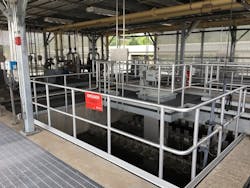Overview
The Department of Energy and Environmental Protection issued a nutrient management strategy for freshwater non-tidal streams focusing on seasonal phosphorus limits of 0.1 mg per L per month. The Pequabuck River was identified as one of those streams, and a high priority was placed on managing and reducing the nutrient loads and their potential for contributing to water quality impairments.
To meet these new requirements, the city of Bristol set out to reduce phosphorus effluent loads from their Water Pollution Control Facility (WPCF) into the Pequabuck River. Given the high level of phosphorus removal needed, ballasted clarification was the chosen technology and four manufacturers were considered and evaluated. The evaluation took into consideration a number of factors including the ability to fit within a limited site footprint, process experience in low effluent phosphorus applications, ease of maintenance and operation, as well as installation and operating costs. The successful manufacturer also had to prove performance thru onsite pilot testing.
The Solution
The Actiflo high-rate clarification system has been in operation at Bristol’s WPCF since October of 2017. Actiflo is a compact clarification system that utilizes the combination of coagulation, flocculation and sedimentation using microsand as a seed for floc formation. The microsand provides surface area that enhances flocculation and acts as a ballast to enable rapid settling of coagulated material. Actiflo has been successfully treating tertiary wastewater for phosphorus removal for over 20 years with over 20 installations in the U.S. and another 60 plus worldwide, many of which are meeting ultra-low phosphorus levels lower than 0.08 mg per L.
As seen through the first year and a half of operation, the flexibility of the process will ensure the city meets current and future limits for phosphorus under a wide range of influent conditions.



